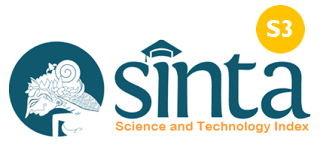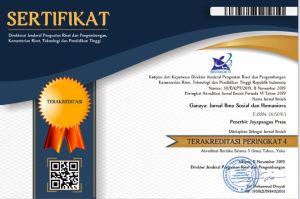Visualisasi Proses Vulkanisme melalui Media Pembelajaran Animasi berbasis Augmented Reality sebagai Media Digital Geografi
DOI:
https://doi.org/10.37329/cetta.v7i2.3296Keywords:
Augmented Reality, Volcanism, Geographic Media DigitalAbstract
Technological developments have experienced rapid progress which has an impact on the field of education. Technology is also a means of digital media in delivering material to students. This research developed an Augmented Reality (AR) in the form of the VULK-AR application as digital geographic media. The VULK-AR application is a new innovation in the process of volcanism and 3 types of volcanoes by combining various components in it. This research aims to explore the potential of Augmented Reality-based animation learning media and visualize the process of volcanism. This development uses the Research and Development (R&D) method with the SAM 1 model. Through the integration of AR with geography content, students can understand natural phenomena directly, and enable active learning experiences. The validation test results show that media experts provide a feasibility percentage of 92.84%, and material experts 89.55%. Product trials were carried out on teachers, the percentage obtained was 84.61% and students were 89.75%. The advantages of the VULK-AR application in geographic digital media can foster innovation in the field of technology in geography learning. It is hoped that this research can make a positive contribution in the development of digital geographic media on volcanism material.
References
Abidinsyah, A., Ramdiah, S., & Royani, M. (2019). The implementation of local wisdom-based learning and HOTS-based assessment: Teacher survey in Banjarmasin. Jurnal Pendidikan Biologi Indonesia, 5(3), 407–414.
Afifah, N., Putra, A. K., & Haqqi, A. H. (2024). Virtual Reality Integration in Geography : Meningkatkan Environmental Problem Solving Ability Siswa pada Kajian Konservasi DAS. Journal of Education Action Research, 8(1), 11–22.
Aguayo, C., Cochrane, T., & Narayan, V. (2017). Key themes in mobile learning: Prospects for learner-generated learning through AR and VR. Australasian Journal of Educational Technology, 33(6), 27–40.
Allen, W. Michael & Sites, Richard. (2012). Leaving ADDIE for SAM: An Agile Model for Developing the Best Learning Experiences. American Society for Training and Development.
Al Shuaili, K., Al Musawi, A. S., & Hussain, R. M. (2020). The effectiveness of using augmented reality in teaching geography curriculum on the achievement and attitudes of Omani 10th Grade Students. Multidisciplinary Journal for Education, Social and Technological Sciences, 7(2), 20-29.
Anrichal, R., & Pramono, D. (2023). Strategi Adaptasi dan Dampak Implementasi Platform Merdeka Mengajar di SMA Kesatrian 2 Kota Semarang. Jurnal Ilmiah Profesi Pendidikan, 8(4), 2197-2209.
Arif, S. H., Handoyo, B., & Rosyida, F. (2022). Pengembangan media pembelajaran Geografi menggunakan augmented reality pada materi vulkanisme berbasis spasial. Jurnal Integrasi Dan Harmoni Inovatif Ilmu-Ilmu Sosial, 2(2), 184–193.
Arikunto, S. (2009). Dasar-dasar Evaluasi Pendidikan (edisi revisi). Jakarta: Bumi Aksara.
Aripin, I., & Suryaningsih, Y. (2019). Pengembangan Media Pembelajaran Biologi Menggunakan Teknologi Augmented Reality (AR) Berbasis Android pada Konsep Sistem Saraf. Sainsmat Jurnal Ilmu Pengetahuan Alam, 8(2), 47.
Damanik, E. M., & Suharyanto, C. E. (2020). Perancangan Aplikasi Pembelajaran Geografi Berbasis Android. Computer and Science Industrial Engineering, 3(2).
Dewi, K., & Sahrina, A. (2021). Urgensi Augmented Reality sebagai Media Inovasi Pembelajaran dalam Melestarikan Kebudayaan. Jurnal Integrasi dan Harmoni Inovatif Ilmu-Ilmu Sosial, 1(10), 1077-1089.
Fenais, A., Ariaratnam, S. T., Ayer, S. K., & Smilovsky, N. (2019). Integrating Geographic Information Systems and Augmented Reality for Mapping Underground Utilities. Infrastructures, 4(4).
Freitas, C. D. T., Silva, R. O., Ramos, M. V., Porfírio, C. T. M. N., Farias, D. F., Sousa, J. S., Oliveira, J. P. B., Souza, P. F. N., Dias, L. P., & Grangeiro, T. B. (2020). Identification, characterization, and antifungal activity of cysteine peptidases from Calotropis procera latex. Phytochemistry, 169, 112163.
Habibiyah, Z. M., Masruroh, H., & Putra, A. K. (2023). Analyzing the Needs for Augmented Reality-Based Learning Media in Geography Education: A Case Study of Landform Material. Atlantis Press: International Conference on Social Knowledge Sciences and Education, 13-24.
Hartiyani, S. D., & Ghufron, A. (2020). Pengembangan Dan Kelayakan Multimedia Berbasis Android Untuk Pembelajaran Bahasa Arab di Islamic Boarding School Bina Umat. Kwangsan: Jurnal Teknologi Pendidikan, 8(2), 332457.
Hashim, H. (2018). Application of Technology in the Digital Era Education. International Journal of Research in Counseling and Education, 1(2), 1.
Haswin, A., & Putra, A. K. (2024). Pengembangan Virtual Tour 360ᵒ sebagai Media Belajar IPS Materi Kepulauan Maritim. Jurnal Integrasi dan Harmoni Inovatif Ilmu-Ilmu Sosial, 4(8), 6-6.
Hayuantara, I. (2020). Pengembangan Media Pembelajaran Berbasis Augmented Reality Book Pelajaran Geografi Sub Pokok Bahasan Litosfer dengan Konsep Gamification (Studi Kasus: SMA Laboratorium Undhiksa Singaraja). Doctoral dissertation, Universitas Pendidikan Ganesha.
Hedley, D., Uljarević, M., Foley, K. R., Richdale, A., & Trollor, J. (2018). Risk and protective factors underlying depression and suicidal ideation in Autism Spectrum Disorder. Depression and Anxiety, 35(7), 648–657.
Kristanti, Q. V. D., & Putra, A. K. (2024). Pemanfaatan 3D Maps Berbasis Google Earth untuk Membangun Kesadaran Spasial Kebencanaan di Era Society 5.0. Jurnal MIPA dan Pembelajarannya (JMIPAP), 4(2), 4-4.
Kurniawati, M., Santanapurba, H., & Kusumawati, E. (2019). Penerapan Blended Learning Menggunakan Model Flipped Classroom Berbantuan Google Classroom Dalam Pembelajaran Matematika Smp. EDU-MAT: Jurnal Pendidikan Matematika, 7(1), 8–19.
Kustandi, C., Farhan, M., Zianadezdha, A., Fitri, A. K., & L, N. A. (2021). Pemanfaatan Media Visual Dalam Tercapainya Tujuan Pembelajaran. Akademika, 10(2), 291–299.
Lahay, R. J., & Mohamad, N. (2020). Peta Puzzle 3D berbasis Mobile Augmented Reality sebagai Prototipe Media Pembelajaran Geografi. Jambura Geo Education Journal, 1(1), 26-31.
Lahay, R. J. (2023). Visualization of Volcanic Landform with Augmented Reality. Jambura Geo Education Journal,15(2), 230-235.
Lukman, M. I., Handoyo, B., & Utomo, D. H. (2021). Pengembangan Sumber Belajar Geografi Berbasis Spasial dengan Augmented Reality untuk Meningkatkan Kemampuan Berpikir Tingkat Tinggi. Jurnal Pendidikan: Teori, Penelitian, dan Pengembangan, 6(12), 1869-1875.
Nafisah, D., & Ghofur. (2020). Pengembangan Media Pembelajaran Scan Barcode Berbasis Android Dalam Pembelajaran Ips. EduTeach: Jurnal Edukasi Dan Teknologi Pembelajaran, 1(2), 144–152.
Nugraha, H., Rusmana, A., Khadijah, U., & Gemiharto, I. (2021). Microlearning Sebagai Upaya dalam Menghadapi Dampak Pandemi pada Proses Pembelajaran. Jurnal Inovasi Dan Teknologi Pembelajaran: Kajian Dan Riset Dalam Teknologi Pembelajaran, 8(3), 225–236.
Panduwinata, L. F., Wulandari, R. N. A., & Zanky, M. N. (2021). Pengembangan Media Pembelajaran berbasis Augmented Reality (AR) pada Materi Prosedur Penyimpanan Arsip. Lectura: Jurnal Pendidikan, 12(1), 15-28.
Pramono, A., & Setiawan, M. D. (2019). Pemanfaatan Augmented Reality Sebagai Media Pembelajaran Pengenalan Buah-Buahan. INTENSIF: Jurnal Ilmiah Penelitian Dan Penerapan Teknologi Sistem Informasi, 3(1), 54.
Putra, A. K., Khalidy, D. A., Handoyo, B., Soekamto, H., Kristanti, Q. V. D., Kholifah, E. N., Putri, D. P. A., & Ayu, Y. F. P. (2024). Inovasi Merdeka Belajar : Pelatihan Penerapan Microlearning dan Inovasi Merdeka Belajar : Pelatihan Penerapan Microlearning Microcontent untuk Pembelajaran Geografi Berdiferensiasi. Jurnal Pengabdian Magister Pendidikan IPA, 7(1).
Putra, A. K., Purwanto, Islam, M. N., Hidayat, W. N., & Fahmi, M. R. (2022). Development of Mobile Virtual Field Trips in Ijen Crater Geosites Based on 3600 Auto Stereoscopic and Geospatial Technology As Geography Learning Media. Geojournal of Tourism and Geosites, 41(2), 456–463.
Putri, G. B., Putra, A. K., Romero, D. C. A., & Samsul (2024). Student Perceptions about the Use of Immersive Media Virtual Field Learning Study of Ijen Geosite Geopark on Interests in Studying Banyuwangi Geography. Future Space: Studies in Geo-Education, 1(2), 145-163.
Ramdani, A., Jufri, A. W., & Jamaluddin, J. (2020). Pengembangan Media Pembelajaran Berbasis Android pada Masa Pandemi Covid-19 untuk Meningkatkan Literasi Sains Peserta Didik. Jurnal Kependidikan: Jurnal Hasil Penelitian Dan Kajian Kepustakaan Di Bidang Pendidikan, Pengajaran Dan Pembelajaran, 6(3), 433–440.
Sari, I. N., & Sulisworo, D. (2023). Pengembangan LKPD Berbasis Augmented Reality Sebagai Media Pembelajaran Matematika. Jurnal Nasional Pendidikan Matematika, 7(1), 1-11.
Seviana, R., Suharto, Y., Rosyida, F., & Masitoh, F. (2023). Aplikasi Volcano Berbasis Android Pada Materi Vulkanisme Sebagai Media Microlearning Geografi. Jurnal Ilmiah Pendidikan Profesi Guru, 6(1), 196–208.
Syahputra, M. F., Hardywantara, F., & Andayani, U. (2020). Augmented Reality Virtual House Model Using ARCore Technology Based on Android. Journal of Physics: Conference Series, 1566(1), 012018.
Umam, Q., & Sunaryo, S. (2019). Toplesfer: Media Sederhana Untuk Mendukung Pembelajaran Demonstrasi Pada Pelajaran Geografi. Jurnal Ilmiah Ilmu Sosial, 5(2), 81-90.
Wahyuni, S., Indrawati, I., Sudarti, S., & Suana, W. (2017). Developing science process skills and problem-solving abilities based on outdoor learning in junior high school. Jurnal Pendidikan IPA Indonesia, 6(1), 165–169.
Widyanti, R. (2021). Pengembangan E-Modul Berbantuan Augmented Reality Terintegrasi STEM untuk Melatih Keterampilan Berpikir Kreatif Siswa. Doctoral dissertation, Universitas Lampung.
Yulfa, A., Arif, D. A., Ernawati, E., Susetyo, B. B., Wijayanto, B., Andreas, A., & Fauzi, T. I. (2022). Pembangunan Geo-Augmented Reality untuk Pengembangan Pembelajaran Geografi Berbasis Project Based Learning. Abdi: Jurnal Pengabdian dan Pemberdayaan Masyarakat, 4(1), 199-204.
Downloads
Published
How to Cite
Issue
Section
License
Copyright (c) 2024 Alifah Salsabila, Alfyananda Kurnia Putra

This work is licensed under a Creative Commons Attribution-ShareAlike 4.0 International License.
An author who publishes in the Cetta : Jurnal Ilmu Pendidikan agrees to the following terms:
- Author retains the copyright and grants the journal the right of first publication of the work simultaneously licensed under the Creative Commons Attribution-ShareAlike 4.0 License that allows others to share the work with an acknowledgement of the work's authorship and initial publication in this journal
- Author is able to enter into separate, additional contractual arrangements for the non-exclusive distribution of the journal's published version of the work (e.g., post it to an institutional repository or publish it in a book) with the acknowledgement of its initial publication in this journal.
- Author is permitted and encouraged to post his/her work online (e.g., in institutional repositories or on their website) prior to and during the submission process, as it can lead to productive exchanges, as well as earlier and greater citation of the published work (See The Effect of Open Access).
Read more about the Creative Commons Attribution-ShareAlike 4.0 Licence here: https://creativecommons.org/licenses/by-sa/4.0/.





